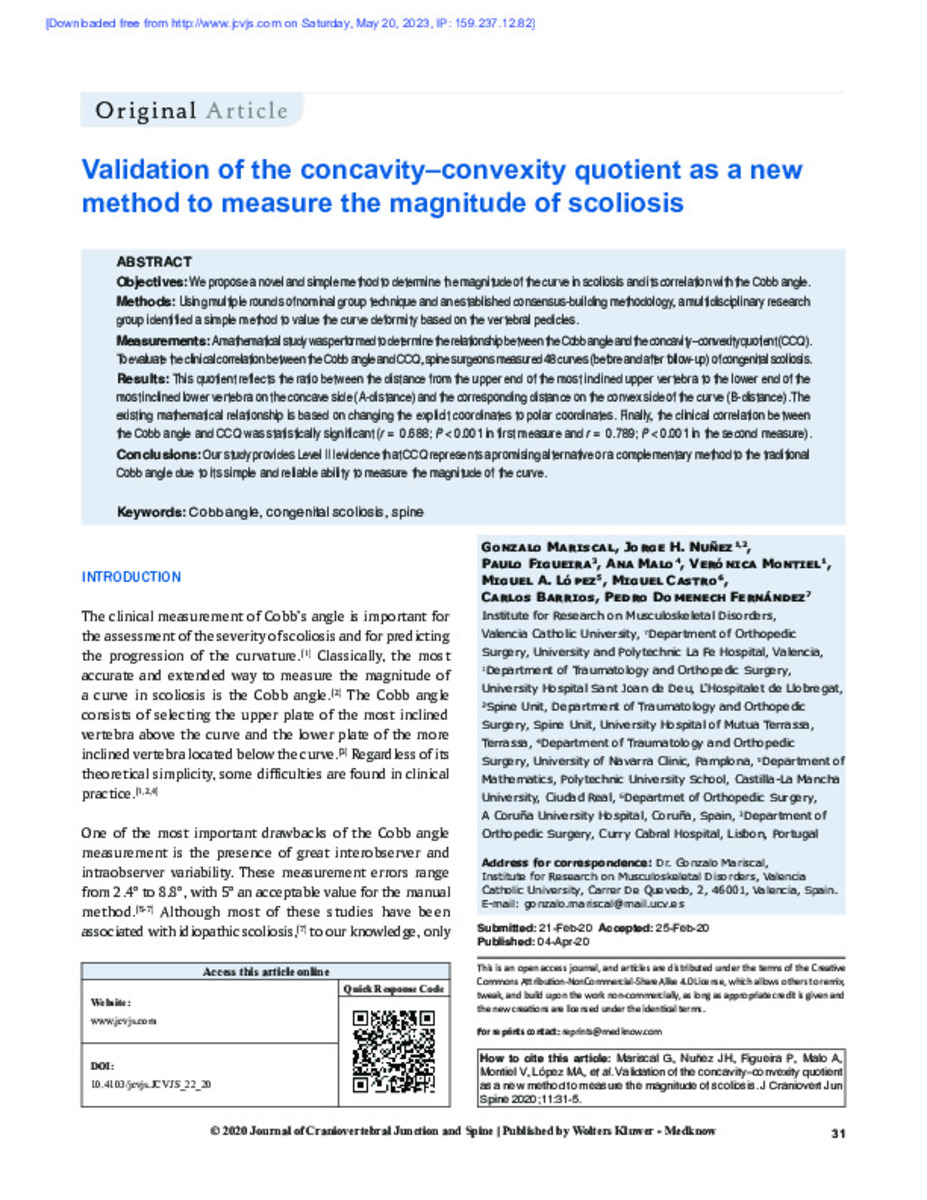Full metadata record
| DC Field | Value | Language |
|---|---|---|
| dc.creator | Mariscal, G. (Gonzalo) | - |
| dc.creator | Nuñez, J.H. (Jorge H.) | - |
| dc.creator | Figueira, P. (Paulo) | - |
| dc.creator | Malo, A. (Ana) | - |
| dc.creator | Montiel-Terrón, V. (Verónica) | - |
| dc.creator | López, M.A. (Miguel A.) | - |
| dc.creator | Castro, M. (Miguel) | - |
| dc.creator | Barrios, C. (Carlos) | - |
| dc.creator | Domenech-Fernández, P. (Pedro) | - |
| dc.date.accessioned | 2023-08-16T11:23:20Z | - |
| dc.date.available | 2023-08-16T11:23:20Z | - |
| dc.date.issued | 2020 | - |
| dc.identifier.citation | Mariscal, G. (Gonzalo); Nuñez, J.H. (Jorge H.); Figueira, P. (Paulo); et al. "Validation of the concavity-convexity quotient as a new method to measure the magnitude of scoliosis.". Journal of craniovertebral junction & spine. 11 (1), 2020, 31 - 35 | es |
| dc.identifier.issn | 0974-8237 | - |
| dc.identifier.uri | https://hdl.handle.net/10171/67138 | - |
| dc.description.abstract | Objectives: We propose a novel and simple method to determine the magnitude of the curve in scoliosis and its correlation with the Cobb angle. Methods: Using multiple rounds of nominal group technique and an established consensus‑building methodology, a multidisciplinary research group identified a simple method to value the curve deformity based on the vertebral pedicles. Measurements: A mathematical study was performed to determine the relationship between the Cobb angle and the concavity–convexity quotient (CCQ). To evaluate the clinical correlation between the Cobb angle and CCQ, spine surgeons measured 48 curves (before and after follow‑up) of congenital scoliosis. Results: This quotient reflects the ratio between the distance from the upper end of the most inclined upper vertebra to the lower end of the most inclined lower vertebra on the concave side (A‑distance) and the corresponding distance on the convex side of the curve (B‑distance). The existing mathematical relationship is based on changing the explicit coordinates to polar coordinates. Finally, the clinical correlation between the Cobb angle and CCQ was statistically significant (r = −0.688; P < 0.001 in first measure and r = −0.789; P < 0.001 in the second measure). Conclusions: Our study provides Level III evidence that CCQ represents a promising alternative or a complementary method to the traditional Cobb angle due to its simple and reliable ability to measure the magnitude of the curve. | es_ES |
| dc.language.iso | eng | es_ES |
| dc.publisher | Wolters Kluwer | es_ES |
| dc.rights | info:eu-repo/semantics/openAccess | es_ES |
| dc.subject | Cobb angle | es_ES |
| dc.subject | Congenital scoliosis | es_ES |
| dc.subject | Spine | es_ES |
| dc.title | Validation of the concavity-convexity quotient as a new method to measure the magnitude of scoliosis. | es_ES |
| dc.type | info:eu-repo/semantics/article | es_ES |
| dc.description.note | This is an open access journal, and articles are distributed under the terms of the Creative Commons Attribution‑NonCommercial‑ShareAlike 4.0 License, which allows others to remix, tweak, and build upon the work non‑commercially, as long as appropriate credit is given and the new creations are licensed under the identical terms. | es_ES |
| dc.identifier.doi | 10.4103/jcvjs.JCVJS_22_20 | - |
| dadun.citation.endingPage | 35 | es_ES |
| dadun.citation.number | 1 | es_ES |
| dadun.citation.publicationName | Journal of craniovertebral junction & spine | es_ES |
| dadun.citation.startingPage | 31 | es_ES |
| dadun.citation.volume | 11 | es_ES |
| dc.identifier.pmid | 32549710 | - |
Files in This Item:
Statistics and impact
Items in Dadun are protected by copyright, with all rights reserved, unless otherwise indicated.






